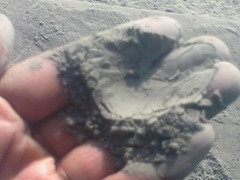Field
tests on cements are carried to know the quality of cement supplied at
site. It gives some idea about cement quality based on colour, touch and
feel and other tests.

(b) The cement should be free from any hard lumps. Such lumps are formed by the absorption of moisture from the atmosphere. Any bag of cement containing such lumps should be rejected.
(c)
The cement should feel smooth when touched or rubbed in between
fingers. If it is felt rough, it indicates adulteration with sand.
(d) If hand is inserted in a bag of cement or heap of cement, it should feel cool and not warm.
(e) If a small quantity of cement is thrown in a bucket of water, the particles should float for some time before it sink.
(f) A thick paste of cement with water is made on a piece of glass plate and it is kept under water for 24 hours. It should set and not crack.
(g) A block of cement 25 mm ×25 mm and 200 mm long is prepared and it is immersed for 7 days in water. It is then placed on supports 15cm apart and it is loaded with a weight of about 34 kg. The block should not show signs of failure.
(h) The briquettes of a lean mortar (1:6) are made. The size of briquette may be about 75 mm ×25 mm ×12 mm. They are immersed in water for a period of 3 days after drying. If cement is of sound quality such briquettes will not be broken easily.

The following are the field tests on cement:
(a) The colour of the cement should be uniform. It should be grey colour with a light greenish shade.(b) The cement should be free from any hard lumps. Such lumps are formed by the absorption of moisture from the atmosphere. Any bag of cement containing such lumps should be rejected.
(d) If hand is inserted in a bag of cement or heap of cement, it should feel cool and not warm.
(e) If a small quantity of cement is thrown in a bucket of water, the particles should float for some time before it sink.
(f) A thick paste of cement with water is made on a piece of glass plate and it is kept under water for 24 hours. It should set and not crack.
(g) A block of cement 25 mm ×25 mm and 200 mm long is prepared and it is immersed for 7 days in water. It is then placed on supports 15cm apart and it is loaded with a weight of about 34 kg. The block should not show signs of failure.
(h) The briquettes of a lean mortar (1:6) are made. The size of briquette may be about 75 mm ×25 mm ×12 mm. They are immersed in water for a period of 3 days after drying. If cement is of sound quality such briquettes will not be broken easily.
useful post
ReplyDelete